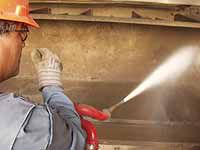| A worker in the car tipper building washes out a train car after it is dumped out. ECDC prides itself on orderliness and cleanliness. |
Carbon County’s history is full of stories of industry providing valuable resources to other markets.
It has a long history of industry, with exports of one kind or another providing the bulk of jobs since the area was settled in the late 1800’s. At first the way of living depended largely on agriculture, but soon, when coal was discovered in large quantities in eastern Utah, the railroad was pushed through, and Carbon County coal was not only used to power the steam engines of the day that pushed over the canyon and toward the flats of the Colorado Plateau, but was sent to markets all over the country. Then came the huge power plants of the area, where coal was consumed right on site, and the export became power sent to the Wasatch Front, California and other places.
In recent years methane gas, that plagued the mines for years, has become a huge source of income for the area, with new wells going in monthly and huge pipelines carrying that resource to various markets being installed and constantly updated.
Today the electric power still flows to markets in the western United States, but the coal industry has even grown up more, with Carbon County coal now going to more western and foreign markets than ever by truck and by diesel electric locomotives. Over the years those trucks and trains have also brought a lot of goods to the area, supplying the energy industry and the population that supports those businesses with everything they need to keep going.
Carbon has always been a huge exporter, relying on the natural resources of the area to supply it’s way of life. But 10 years ago that began to change; suddenly a large import that has grown every year since it began to come into the area. In a way, the coal and gas that has been taken out of the ground for the last century is now being replaced by that import. And in another way, again, a natural resource of the county is being used to accommodate it; large tracts of barren, previously unused land.
In September of 1992, the first car of household waste from the Wasatch Front was brought to the East Carbon Development Corporation’s new facility. The individuals who had the dream of turning other people’s refuse into profits and jobs for the community, Harold Marston, Nick Sampinos, Steve Creamer, Jerry Gagner, Steve Mason and Doug Foxley saw their endeavor start to grow from day one.
| The first dump station that ECDC used on train containers still stands on the east side of the property, Operations been replaced by more modern equipment. |
Today ECDC ranks as one of the areas largest employers, with 50 employees on the payroll. Many houses that stood empty in East Carbon, Sunnyside and Columbia in 1990 are now occupied largely because of ECDC as well as the construction of the Sunnyside Co-Generation Plant. The economy of the whole county has been affected by what others throw away.
Those first cars that came from the Wasatch Front grew into train loads, from new disposal transfer stations in Utah, Weber and Salt Lake counties. Soon out of state contracts were signed and refuse from as far away as Boston began to arrive.
But the disposal of just household waste (or MSW as it is called in the disposal industry) wasn’t the only service ECDC provided to customers. In the early stages of the facility, special project disposal became a priority, with the landfill accepting industrial and construction waste as well. ECDC’s first industrial project was accepting dirty dirt and debris for the Southern Pacific J Rail Yard. In the early stages of the landfill the California Department of Transportation was a big user of the facility. Contrary to popular belief that did not include the McArthur Freeway debris that was created during the 1989 northern California earthquake.
And when General Motors needed a place to dispose of plant cleanups going on in various places around the country ECDC provided a special cell site just for that waste. The facility has served industry and the country well, by relieving local, overloaded and overextended landfills with an alternative.
Of course nothing with this type of magnitude begins or survives without controversy. When the idea was proposed in the late 1980’s many thought the idea of bringing waste to Carbon County was a slap in the face and would eventually lead to some type of environmental disaster. But with tight controls in one of the most heavily regulated industries in the country. ECDC has proven it’s worth by providing not only jobs but over 15 million dollars of taxes to public entities in Utah since it opened.
The story of ECDC and the way it operates may be one filled with controversy, but it is also packed to the brim with success.

